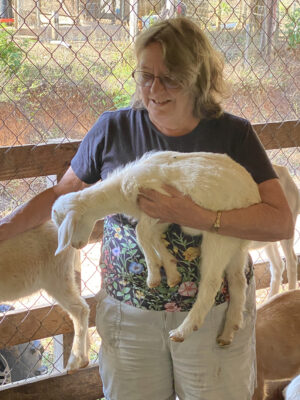By Pat Foster-Turley

I’ve heard the term “farm to table” often these days, but never have I experienced it as succinctly as I have at the Mystic River Lodge in Belize. This luxury resort in the Maya Mountains prides itself on its farm full of livestock and its large vegetable garden and orchards. Much of the food they serve originated on their grounds.
One day at the resort, I signed up for a farm tour, and soon I was riding up to their farm in a Jeep up a rutted, dirt road impassable to normal cars. A Mayan couple, Martin and Amari Mendez, greeted us beside their livestock pens and filled us with information. The resort has more than 120 animals, mostly goats, pigs and chickens, which provide some of the protein consumed in their restaurant. But I wasn’t thinking about that then.
Martin was quick to show us tourists all the goat kids corralled in one pen and encouraged us to enter and cuddle the goats. Before I knew it, I was cradling a small white kid in my arms, while another goat tried to eat the flowers that adorned my t-shirt. When it became clear that I knew a bit about animal husbandry, Martin explained the specialized veterinary care needed to keep the goats healthy in this tropical climate.

The goats are free during the day to roam one of the five large pastures that Martin is responsible for keeping seeded with grass and vegetation to nourish them. But the goats cannot be let out before 9 a.m. when the temperatures go up. When the mornings are still cool, parasitic worms are at the surface, he explained, and these will infect the goats but the worms recede in the heat of the day. And then there is the problem with vampire bats. Like most bats, these are active at night, when they attack goats and other animals to extract their bloody meals. And, studies have shown that about 50% of the vampire bats in this area of Belize are infected with rabies! So, all the goats need to be vaccinated against rabies, and lights are kept on in the goat pens at night to deter the bats. And then there are also the prowling “red lions” to deal with. Martin and Amari have two dogs that patrol the grounds at night, barking when any predators come near. So far, they have only heard the calls and tracks of the red lions (aka cougars) and have had no incidents, but they know they are around.
We visitors paid a quick visit to the pigs, and admired the roaming chickens and turkeys but then were led to the milking area. One by one, each nanny goat was released from the pen and quickly jumped up onto the milking platform, where Amari demonstrated the art of milking goats. I took my try at it, and, with much help, only managed to squeeze out a small jet of milk from the full udders, nothing like the strong jet of milk that Amari extracted. The nanny goats, meanwhile, were unperturbed about the novices trying to milk them. They had their heads in a feed trough filled with some sort of delectable goat food, which was all that seemed to matter to them.

Everything possible was put to good use from the farm. The pelleted goat droppings in the pen were shoveled out every few days onto a large pile to age for two months into soil amendments used to fertilize their many acres of vegetable gardens and fruit trees. When I explored the gardens on my own later, I found rows of ripe tomatoes, eggplants, cantaloupes, squash, and all manner of greens, and soon, a large crop of oranges and mangoes would be ready for harvest, too.
In the resort restaurant, Bucko and I dined on salads with fresh picked greens, tomatoes, cucumbers and onions. We shared a plate of five varieties of homemade goat cheese. Our main courses were goat curry and simmered pork leg served with bok choy from the garden and the typical rice. Upon questioning, the waiter told me that the pig had been butchered just the day before, as fresh as food can get. And the goat curry? The meat was very tender, surely a young goat. Maybe it was one I had cuddled a couple of days before, who knows? I really didn’t want to.
This was farm to table at its best. It took a trip to Belize for me to see it full circle.
Pat Foster-Turley, Ph.D., is a zoologist on Amelia Island. She welcomes your nature questions and observations. [email protected]
